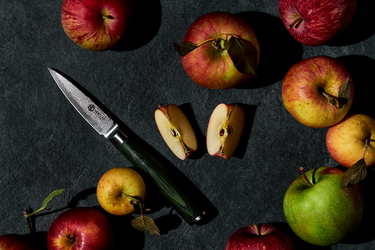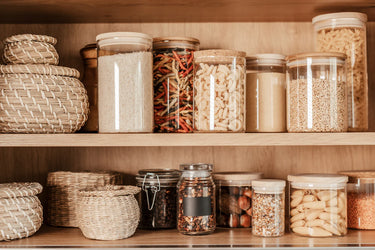Joanne Molinaro Wants You To Include These Superstar Korean Vegan Ingredients In Your Cooking

If you’ve ever wondered whether you should add gochujang or kimchi to non-Korean dishes, Joanne Molinaro is here to tell you that you absolutely should. Tuck a dab of the spicy, fermented pepper paste into your marinara? Of course! Stir kimchi into a Southwestern-style chili? Yes, please. A trained attorney, Molinaro brings the trademark dedication of a lawyer to her plant-based Korean and Korean-inspired cooking. As her popular website, The Korean Vegan, attests, Molinaro loves to veganize Korean food—a cuisine rich in meat and fish—and to Koreanize “everything else.” The kitchens (and bellies) of her readers and followers on her Instagram and TikTok accounts are the better for it.
HexClad was lucky to hang out in the kitchen with Molinaro, who showed us how to make her Tteokbokki (spicy Korean rice cakes). Tteokbokki is the most popular street food in Korea, says Molinaro, and though a lot of non-Koreans might not have known about this tasty dish even two years ago, it’s gaining popularity in the United States. The rice cakes that make up the bulk of the dish are made from steamed, milled rice.
Molinaro keeps her tteokbokki recipe simple, like the street food vendors. “It’s usually eaten with a little toothpick,” she says, “So adding too much to the dish would make it difficult to eat.” That being said, it’s a flexible dish, so if you’d like to add veggies, Molinaro says to go for it. She likes adding broccoli, squash, mushrooms, carrot, or zucchini to tteokbokki.

Here are Molinaro’s tips for the best tteokbokki:
- Buy your tteok (rice cakes) fresh, if you can: Though you can buy them frozen at just about any Korean grocery store (or make them yourself, which Molinaro says is a long, arduous process that yields a small amount), the best rice cakes come from Korean bakeries. Molinaro’s biggest tip? Get to the bakery before noon when the cakes are still fresh. That’s how you’ll get the best of the rice cakes, with their soft, chewy texture. If you do buy frozen tteok, just thaw them in the microwave for a couple minutes.
- Infuse the rice cakes with a quick, easy marinade: Though you can use the rice cakes straight away in the tteokbokki recipe, a simple marinade will add a rich, toasty flavor to the rice cakes. Molinaro’s mother taught her to soak the cakes in a quick marinade of Korean toasted sesame oil, salt, and pepper. You don’t need too long. Let the rice cakes soak in the seasoned oil while you prepare your other ingredients, which will also soften them.
- You don’t need anything extra to thicken the sauce: People always ask Molinaro what she does to thicken the sauce for her tteokbokki. Nothing, she says, laughing. Unlike Western sauces, which often rely on flour, cornstarch, or butter to thicken the sauce, tteokbokki doesn’t need it. That’s because the rice cakes are high in starch, which give the luscious, spicy sauce a gravy-like texture.
- For classic tteokbokki heat, gochujang is key: Gochujang, a Korean hot pepper paste made from fermented soy beans, chili powder, sweetener, and flour (sometimes made from wheat, sometimes from rice), injects a wallop of heat into the dish. Molinaro stresses that it’s not just the spiciness of gochujang that’s key to tteokbokki’s popularity. Because it’s fermented, gochujang adds intense umami, a savory quality that plays alongside the heat and adds a depth of flavor without relying on animal products.
GET THE RECIPE: Joanne's Tteobokki Mafaldine
7 Superstar Ingredients From Joanne Molinaro’s Korean Vegan Pantry
Molinaro shared some more tips for infusing your cooking with other superstar Korean ingredients, whether you happen to eat vegan or not. A common thread between these ingredients is fermentation. “There’s little better for injecting insane levels of flavor than fermenting your food,” Molinaro says. “When you look at kimchi, soy sauce, gochujang, and other well-known and traditional sources of flavor and texture, the secret is often fermentation.”
- Gochujang - This fermented chili pepper paste adds umami and heat to everything it touches. Molinaro loves stirring it into her marinara sauce to balance the acidic tomatoes. Gochujang features in her chili, too, stirring it in alongside chipotles in adobo and cayenne.
- Gochugaru - The base of gochujang is this Korean red pepper powder, which can be used on its own to finish dishes, to stir into dry rubs, and to use where you would hot paprika, chili flakes, or other ground, dried chili powders.
- Doenjang - A non-spicy version of gochujang, which is often mistaken for miso, doenjang has a deeply concentrated umami flavor and a thick, spreadable texture. Molinaro loves to whisk a tablespoon of doenjang into her maple mustard dressing.
- Soy sauce - Molinaro says that soy sauce adds flavor to vegan dishes that would normally be made with anchovy broth or bone stock.
- Kimchi - “Kimchi is a big part of my diet,” says Molinaro. She stirs kimchi into her chili, marrying it with pinto beans, mushroom, zucchini, and sweet potato. Don’t think you just need to eat kimchi with Korean food, Molinaro insists. Add it to your favorite dishes and see what you like best.
- Dasima (edible dried kelp) - Because Korea is a peninsula, fish-based ingredients are the backbone of the cuisine. Dishes like tteokbokki usually include anchovy broth and fish cake. When Molinaro wants to infuse tteokbokki or other dishes with the essence of the sea, she turns to dasima flakes.
- Tofu - “Tofu has such an unusual reputation,” says Molinaro. Though many view it as a health food or a meat substitute, those categories are irrelevant in Korean food, where it’s an absolute staple. Molinaro and her husband are athletes, so protein-rich tofu features into their diet almost daily.




